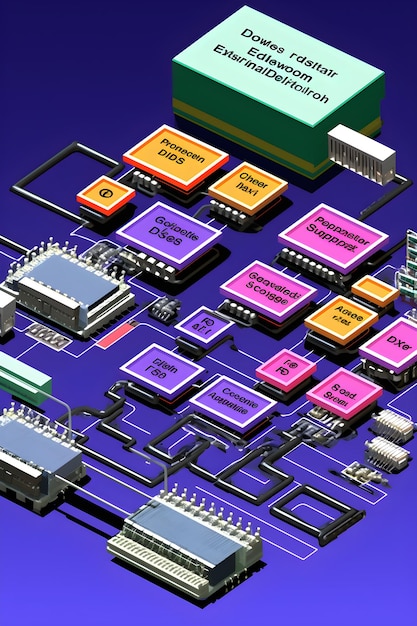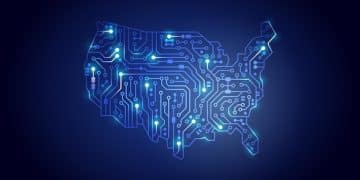Quantum Computing in US: Investments & Challenges 2025

The rise of quantum computing in the US by 2025 signifies a transformative era for technology, presenting substantial investment opportunities alongside significant challenges in an increasingly competitive global landscape.
In the realm of advanced technology, few topics stir as much excitement and anticipation as quantum computing. As 2025 approaches, the United States stands at a pivotal juncture, poised to potentially lead the global charge in this transformative field. The rise of quantum computing in the US: investment opportunities and challenges in 2025 is not merely a technical discussion; it’s a strategic imperative with profound implications for national security, economic growth, and scientific discovery.
Understanding the Quantum Leap: What it Means for the US
Quantum computing represents a paradigm shift from classical computing, leveraging the peculiar phenomena of quantum mechanics—superposition, entanglement, and quantum tunneling—to process information in fundamentally new ways. Unlike classical bits, which can only be 0 or 1, quantum bits (qubits) can exist in multiple states simultaneously, dramatically increasing processing power for specific types of problems.
This isn’t just about faster calculations; it’s about solving problems currently intractable for even the most powerful supercomputers. Imagine developing new drugs with unprecedented accuracy, breaking complex cryptographic codes in seconds, or optimizing supply chains on a global scale with unparalleled efficiency. These are not distant dreams but potential realities as quantum computing matures.
The US has recognized the strategic importance of this technology early on. Significant investments from both government agencies and private enterprises have fueled research and development, creating a vibrant ecosystem of startups, academic institutions, and established tech giants all vying for a piece of the quantum pie. The race is on, and the stakes are incredibly high, influencing everything from economic competitiveness to national defense.
Quantum principles explained
The core of quantum computing lies in three principles that defy classical intuition:
- Superposition: A qubit can be in a state of 0, 1, or both simultaneously until measured. This allows a quantum computer to examine multiple possibilities at once.
- Entanglement: Two or more qubits can become linked such that the state of one instantly influences the state of the other, regardless of distance. This creates powerful correlations useful for computation.
- Interference: Quantum computers can use wave-like interference patterns to amplify correct answers and cancel out incorrect ones, guiding calculations towards efficient solutions.
These principles, while complex, are the bedrock of quantum advantage. The ability to manipulate these quantum states is what gives quantum computers their potential edge over classical systems, particularly for problems that grow exponentially in complexity. The ongoing challenge for researchers is to harness these delicate quantum effects long enough and error-free enough to perform meaningful computations at scale.
Current State of Quantum Computing in the US: A Snapshot
By 2025, the US quantum computing landscape is characterized by a dynamic interplay of innovation, investment, and strategic partnerships. Major tech companies like IBM, Google, Microsoft, and Amazon are heavily invested, developing their own quantum hardware and cloud-based quantum services. Simultaneously, a burgeoning ecosystem of startups is emerging, specializing in specific aspects of quantum hardware, software, and algorithms.
Government funding, primarily through agencies like the National Quantum Initiative (NQI), has been instrumental in accelerating research and development. The NQI, signed into law in 2018, allocated significant resources to quantum information science, fostering collaboration between federal agencies, academia, and industry. This cohesive national strategy aims to maintain the US’s competitive edge in quantum technology.
Academic institutions, often working in conjunction with corporate and government partners, are at the forefront of fundamental research. Universities across the country are establishing dedicated quantum research centers, training the next generation of quantum scientists and engineers, and pushing the boundaries of quantum theory and practical application.
Key Players and Research Hubs
America’s quantum momentum is driven by a diverse group of entities. Major corporations are investing billions, with IBM offering cloud access to its quantum processors and Google making strides in quantum supremacy demonstrations. Microsoft is focusing on topological qubits, while Amazon Web Services provides quantum computing resources through its Braket service, democratizing access. Beyond these giants, numerous startups like IonQ, Rigetti, and PsiQuantum are emerging as formidable innovators, each bringing unique approaches to hardware and software development. These companies are pushing the boundaries of qubit stability, error correction, and algorithm development, often securing substantial venture capital funding based on their promising breakthroughs.
On the government front, national labs such as Argonne, Oak Ridge, and Lawrence Berkeley are conducting foundational research, often in conjunction with university partners. These labs serve as crucial hubs for developing cutting-edge quantum technologies and training the specialized workforce required for this burgeoning industry. The synergy between corporate, academic, and governmental efforts creates a potent environment for rapid advancement.
The research hubs are not merely confined to one region; they are spread across the country. Quantum ecosystems are flourishing in places like Silicon Valley, Boston, Chicago, and the Washington D.C. metropolitan area, drawing talent and investment. This distributed approach contributes to a robust and resilient quantum landscape, leveraging regional strengths and specialized expertise.
Investment Opportunities in US Quantum Computing by 2025
The burgeoning quantum computing sector in the US offers a myriad of investment opportunities across various segments. From hardware development and software platforms to specialized applications and ancillary services, the potential for significant returns is attracting both traditional venture capital firms and strategic corporate investors.
Hardware Innovation
Investing in quantum hardware is perhaps the most fundamental opportunity. This includes companies developing different qubit technologies (superconducting, trapped ion, photonic, topological), each with its own advantages and challenges. As the technology matures, breakthroughs in qubit stability, connectivity, and error rates will be critical.
Companies building cryogenic systems, vacuum chambers, and specialized control electronics also present significant investment potential, as this infrastructure is essential for operating quantum computers. The sheer complexity and capital intensity of hardware development mean that early-stage funding can yield substantial returns if the underlying technology proves scalable and effective.
Software and Algorithm Development
While hardware captures much of the headlines, the software layer is equally crucial. Investment opportunities abound in quantum software development kits (SDKs), programming languages, and operating systems designed to interface with quantum processors. As quantum machines become more accessible, the demand for user-friendly and efficient software will skyrocket.
Beyond programming tools, the development of quantum algorithms for specific applications—such as materials science, drug discovery, financial modeling, and artificial intelligence—represents a massive area for investment. Companies that can translate complex problems into quantum-ready algorithms and demonstrate clear quantum advantage will be highly valued.
Ancillary Services and Ecosystem Support
The quantum ecosystem extends beyond core hardware and software. Opportunities exist in areas such as quantum cybersecurity, where new methods are needed to protect data from quantum attacks, and in quantum sensing and metrology, which leverage quantum phenomena for ultra-precise measurements.
Training and education initiatives, consulting services, and even specialized data center infrastructure for quantum machines also present viable investment avenues. As the industry grows, the need for a skilled workforce and robust supporting infrastructure will become increasingly critical, offering indirect but equally valuable investment prospects.
Challenges and Roadblocks for Quantum Computing in the US 2025
Despite the immense potential and growing investments, the path to widespread quantum computing adoption in the US is fraught with significant challenges. These roadblocks span technical hurdles, economic considerations, workforce development, and geopolitical dynamics, all of which must be addressed for the US to maintain its lead.
Technical Hurdles and Error Correction
The most significant technical challenge remains the inherent fragility of qubits. Quantum states are extremely susceptible to environmental noise, leading to errors and decoherence. Building quantum computers that are both large enough (more qubits) and stable enough (lower error rates) to perform complex, fault-tolerant computations is a monumental engineering feat.
While error correction techniques are being developed, they are resource-intensive, requiring many physical qubits to encode a single logical qubit, thus limiting the effective computational power. Overcoming this “noisy intermediate-scale quantum” (NISQ) era is crucial for unlocking the full potential of quantum computing.
Economic Viability and Return on Investment
The cost of developing, building, and operating quantum computers is staggering. Research and development require massive capital expenditure, and the commercial applications that can justify these costs are still nascent. Investors need clear pathways to return on investment, which often requires demonstrable “quantum advantage” over classical methods for real-world problems.
Defining and achieving quantum advantage for commercially relevant problems is a key challenge. Many potential applications are still theoretical, and demonstrating tangible benefits over highly optimized classical algorithms can be difficult. This economic hurdle necessitates a long-term vision and significant patience from investors.
Workforce Development and Talent Gap
The quantum computing field requires a highly specialized workforce with expertise spanning quantum physics, computer science, engineering, and algorithm design. There is currently a significant shortage of such talent globally, and the US is no exception. Universities and educational institutions are working to address this, but it will take time to build a robust talent pipeline.
Retaining top talent is also a challenge, as competition among companies and nations intensifies. Bridging this talent gap through education, training programs, and international collaboration is essential for sustained growth and innovation in the US quantum ecosystem.
Cybersecurity Implications and National Security
The power of quantum computing carries significant cybersecurity implications, particularly the ability of future quantum computers to break commonly used encryption methods (RSA, ECC) that underpin modern digital security. This “quantum threat” necessitates a transition to quantum-safe cryptography.
The US government and private sector are investing in post-quantum cryptography research and standardization, but the migration to new cryptographic standards is a massive undertaking. Furthermore, the strategic importance of quantum computing means that its development is intertwined with national security, raising concerns about intellectual property theft, espionage, and technological dominance.

US Strategic Imperatives for Quantum Dominance in 2025
Recognizing the transformative potential and the associated challenges, the US has outlined several strategic imperatives aimed at securing and maintaining its leadership in quantum computing by 2025 and beyond. These imperatives reflect a coordinated effort across government, industry, and academia.
One primary imperative involves continued and expanded federal funding for basic and applied quantum research. This includes not only direct grants but also the establishment of national research centers and consortia that foster collaboration and resource sharing. Sustained, predictable funding is crucial for long-term projects that may not yield immediate commercial returns but are vital for foundational breakthroughs. Building upon the success of initiatives like the National Quantum Initiative Act, future legislation will likely focus on strengthening the quantum ecosystem through dedicated budget allocations. These funds are critical for attracting top scientists, providing cutting-edge equipment, and supporting the interdisciplinary nature of quantum research, which often requires significant investment in specialized infrastructure.
Another key imperative is the development of a robust and diverse quantum workforce. This involves investing in STEM education from early stages, creating specialized quantum curricula at universities, and establishing vocational training programs to develop technicians and engineers. Graduate fellowships, postdoctoral programs, and industry-sponsored internships are vital for attracting and retaining top talent. The goal is to ensure a continuous supply of skilled professionals capable of pushing the boundaries of quantum science and technology. Furthermore, attracting a diverse range of perspectives and backgrounds is seen as essential for fostering innovative solutions and preventing groupthink, which can hinder progress in emerging fields.
Ensuring national security in the face of quantum advancements is also paramount. This includes accelerating research and development in post-quantum cryptography to protect critical infrastructure and sensitive data from future quantum attacks. It also involves monitoring global developments in quantum technology and implementing policies to safeguard intellectual property and prevent the proliferation of sensitive quantum technologies to adversarial nations. Proactive measures are being taken to ensure that the US maintains a defensive advantage in the quantum realm. The intelligence community and defense agencies are actively engaged in understanding the implications of quantum computing for cybersecurity and developing countermeasures long before quantum computers become a practical threat to current encryption standards.
Fostering Public-Private Partnerships
Collaboration between government, industry, and academia is a cornerstone of the US quantum strategy. Public-private partnerships enable the sharing of resources, expertise, and risks, accelerating the transition of fundamental research into practical applications. Initiatives like quantum testbeds and shared computing facilities facilitate access for smaller companies and researchers. These partnerships also help to align research priorities with national strategic goals and market needs, ensuring that investments yield impactful results. They create a virtuous cycle where academic breakthroughs can be rapidly commercialized, and industry needs can inform future research directions, bridging the gap between theoretical science and practical engineering.
International Collaboration and Standards
While there is fierce competition in the quantum race, the US also recognizes the importance of international collaboration where appropriate. This includes sharing best practices in research, developing global standards for quantum technologies, and collaborating on pre-competitive research areas. However, this must be balanced with strategic considerations to protect national interests and maintain a competitive edge. Establishing global standards for quantum hardware and software can accelerate adoption and interoperability, benefiting the entire ecosystem. This balance fine-tunes cooperation versus competition and is crucial given the global nature of scientific advancement and technological development, ensuring that the US remains at the forefront while contributing to a broader quantum future.
What Industries Stand to Benefit from Quantum Computing in the US by 2025?
As quantum computing matures, several key industries in the US are poised to experience significant transformations and derive substantial benefits. These sectors stand to gain from quantum computers’ ability to solve problems currently beyond the reach of classical machines, fostering innovation, efficiency, and new capabilities.
Healthcare and Pharmaceuticals
In healthcare, quantum computing holds immense promise for drug discovery and development. Quantum simulations can model complex molecular interactions with unprecedented accuracy, accelerating the identification of new drug candidates and optimizing drug design. This could lead to faster development of life-saving medicines and personalized treatments.
Quantum machine learning could also enhance diagnostic accuracy, predict disease outbreaks, and personalize treatment plans based on individual patient data. The ability to process vast genomic datasets and simulate biological systems at a fundamental level will revolutionize medical research and patient care.
Financial Services
The financial sector is another prime candidate for quantum disruption. Quantum algorithms can optimize complex financial models, portfolio management, and risk assessment with greater speed and precision than classical methods. This could lead to more robust trading strategies, improved fraud detection, and enhanced financial forecasting.
Quantum computing may also provide new ways to model market fluctuations and perform Monte Carlo simulations more efficiently, offering a significant competitive advantage to institutions that adopt these technologies early. The ability to handle high-dimensional data and complex optimization problems makes quantum computing particularly appealing for financial applications.
Logistics and Supply Chain Optimization
For industries reliant on complex logistics and supply chains, quantum computing offers revolutionary optimization capabilities. Quantum algorithms can solve intricate routing problems, optimize resource allocation, and manage large-scale networks with unparalleled efficiency.
This could lead to significant cost savings, reduced delivery times, and improved responsiveness to market fluctuations. Imagine optimizing global shipping routes, factory floor layouts, or traffic flow in real-time—these are the types of challenges quantum computers are uniquely suited to address. The ability to model and optimize highly interconnected systems provides a significant advantage for managing the complexities of modern global logistics.
Advanced Materials and Manufacturing
Quantum computing will play a crucial role in the design and discovery of new materials with specific properties. By simulating materials at the atomic and molecular level, researchers can engineer novel substances for applications ranging from more efficient batteries and solar cells to advanced lightweight alloys for aerospace.
In manufacturing, quantum optimization can streamline production processes, improve quality control, and optimize factory resource utilization. This could lead to more sustainable manufacturing practices and the creation of next-generation products with superior performance characteristics.

The Future Outlook: Beyond 2025 for US Quantum Computing
While 2025 marks a critical period for the quantum computing landscape in the US, the trajectory of this technology extends far beyond. The foundations laid in the coming years will determine the pace and direction of its evolution, promising a future ripe with transformative potential, albeit accompanied by its own set of emerging challenges.
Looking ahead, we can anticipate a continued focus on scaling up quantum hardware. The current “noisy” qubits will gradually give way to more robust, fault-tolerant systems capable of running complex algorithms with high fidelity. This progression from hundreds to thousands, and eventually millions, of stable qubits is essential for realizing quantum’s full potential in real-world applications. Research will intensify on error correction techniques, which are currently a major bottleneck, alongside the development of novel qubit architectures that are inherently more resilient. This ongoing hardware race will likely see new contenders emerge and existing players refine their approaches.
The development of quantum software and algorithms will also accelerate significantly. As hardware capabilities improve, there will be an increased demand for practical quantum applications that can demonstrate clear quantum advantage. This will drive innovation in quantum programming languages, compilers, and specialized algorithms tailored for specific industry problems. We can expect to see more user-friendly quantum development environments, making the technology accessible to a broader range of developers and researchers beyond the core quantum community.
Ethical considerations and regulatory frameworks will gain prominence. As quantum computing’s capabilities grow, philosophical and practical questions about its responsible use will become more pressing. Discussions around data privacy, algorithmic bias, and the potential for misuse (e.g., breaking current encryption standards) will necessitate careful consideration and the development of international norms and regulations. The US will likely play a leading role in shaping these discussions, aiming to balance innovation with ethical governance.
Global Competition and Collaboration
The quantum race is inherently global. While the US strives for leadership, other nations like China, the UK, Germany, and Japan are heavily investing in their own quantum programs. This competitive landscape will drive innovation but also necessitate strategic international collaborations on pre-competitive research and global standards. Balancing national security interests with the benefits of scientific exchange will be a delicate act. The exchange of ideas among leading quantum scientists across borders, even amid competition, can generate entirely new concepts and accelerate the collective understanding of quantum phenomena. This dual approach of domestic strength and selective international partnership will be crucial.
The Quantum Internet and Beyond
Beyond computing, the concept of a “quantum internet” is gaining traction. This network, based on entangled qubits, could enable ultra-secure communication and distributed quantum computation, opening up entirely new possibilities for secure data transfer and advanced sensing. While still in its nascent stages, a quantum internet represents a tantalizing future application that could fundamentally change how information is shared and secured globally. The long-term vision encompasses a seamlessly integrated quantum ecosystem, where quantum devices, sensors, and computers communicate and operate in a secure, quantum-enhanced environment, truly realizing the full potential of this revolutionary technology.
| Key Aspect | Brief Description |
|---|---|
| 🚀 Investment Growth | Significant capital flowing into hardware, software, and services, driving rapid innovation. |
| 🚧 Core Challenges | Technical hurdles like error correction and qubit stability remain critical. |
| 🎓 Talent Gap | Shortage of skilled quantum professionals, necessitating focused educational initiatives. |
| 🌐 Strategic Imperatives | US prioritizes funding, partnerships, and national security to maintain dominance. |
Frequently asked questions
▼
Quantum computing leverages quantum mechanics principles like superposition and entanglement to process information. Unlike classical computers using bits (0s or 1s), quantum computers use qubits, which can exist in multiple states simultaneously, enabling them to solve complex problems intractable for traditional machines.
▼
Key investment opportunities in the US quantum computing sector by 2025 include hardware innovation (qubit technologies, infrastructure), quantum software and algorithm development, and ancillary services such as quantum cybersecurity and specialized training programs. Early-stage funding towards breakthroughs in these areas holds significant potential.
▼
Significant challenges include technical hurdles like qubit fragility, error correction, and scaling, as well as economic viability in demonstrating clear quantum advantage for commercial problems. Additionally, a talent gap in the specialized workforce and cybersecurity implications pose considerable obstacles for widespread adoption.
▼
Industries poised for significant benefits from quantum computing include healthcare and pharmaceuticals (drug discovery, personalized medicine), financial services (risk modeling, optimization), logistics and supply chain management (route optimization), and advanced materials/manufacturing (new material design, process optimization).
▼
The US is maintaining its quantum leadership through sustained federal funding via initiatives like the National Quantum Initiative, fostering strong public-private partnerships, investing in workforce development through education and training, and developing strategic national security policies, including post-quantum cryptography research, to protect its interests.
Conclusion
The landscape of quantum computing in the US by 2025 is one of immense promise coupled with formidable challenges. As investments continue to flow into hardware, software, and talent development, the nation is steadily advancing towards a future where quantum machines can tackle previously insurmountable problems. While technical hurdles, economic viability, and workforce shortages persist, a concerted effort from government, industry, and academia is aimed at overcoming these obstacles. The strategic imperative for the US to maintain its leadership is clear, encompassing sustained funding, robust partnerships, and proactive measures to safeguard national interests. The transformative potential across industries like healthcare, finance, logistics, and materials science paints a compelling picture of a future shaped by quantum capabilities, extending far beyond the immediate horizon of 2025 towards a truly quantum-enhanced era.





